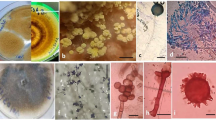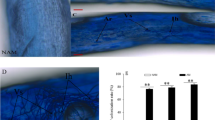Abstract
Mongolian pine is an important afforestation species widely used for ecological management in northeast China. The environment in this region is very unstable and the flora are regularly subjected to drought stress. This paper reports on the influence of inoculation with the Suillus luteus on seedlings under different water conditions. Both inoculated and non-inoculated ectomycorrhizal fungi (ECMF)-S. luteus seedlings were maintained under well-watered or water-stress conditions for 3 months. The S. luteus colonization rate under water stress was higher than that in well-watered conditions. Under water stress, inoculated seedlings had greater growth than non-inoculated seedlings. In addition, under water stress, S. luteus-inoculated seedlings had greater superoxide dismutase and peroxidase activity, higher soluble protein content, lower proline content, and lower malondialdehyde content than non-inoculated seedlings. S. luteus colonization increased the rhizosphere soil-enzyme activity and the rhizosphere soil nutrition content under both well-watered and water-stress conditions. Given the positive impact on seedling growth and physiology, S. luteus shows potential for use in the arid and semi-arid regions of northeast China for afforestation.







Similar content being viewed by others
References
Abbaspour H, Saeidi-Sar S, Afshari H, Abdel-Wahhab MA (2012) Tolerance of Mycorrhiza infected Pistachio (Pistacia vera L.) seedling to drought stress under glasshouse conditions. J Plant Physiol 169:704–709
Baar J, Stanton NL (2000) Ectomycorrhizal fungi challenged by saprotrophic basidiomycetes and soil microfungi under different ammonium regimes in vitro. Mycol Res 104:691–697
Bates LS, Waldren RP, Teare ID (1973) Rapid determination of free proline for water-stress studies. Plant Soil 39:205–207
Bending GD, Read DJ (1995) The structure and function of the vegetative mycelium of ectomycorrhizal Plants. Vl Activities of nutrient moblizing enzymes in birch litter colonized by Paxillus involutus. N Phytol 130:411–417
Birhane E, Sterck FJ, Fetene M, Bongers F, Kuyper TW (2012) Arbuscular mycorrhizal fungi enhance photosynthesis, water use efficiency, and growth of frankincense seedlings under pulsed water availability conditions. Oecologia 169:895–904
Bohnert HJ, Nelson DE, Jensen RG (1995) Adaptations to environmental stresses. Plant Cell 7:1099–1111
Brundrett M, Bougher N, Dell B, Grove T, Malajczuk N (1996) Working with mycorrhizas in forestry and agriculture. Australian Centre for International Agricultural Research Monograph, Canberra, p 32
Cairney JWG, Chambers SM (1999) Ectomycorrhizal fungi-key genera in profile. Springer, Berlin
Christos DG, Konstantinos G, George Z (2008) Mechanism of Coomassie brilliant blue G-250 binding to proteins: a hydrophobic assay for nanogram quantities of proteins. Anal Bioanal Chem 391:391–403
Edda S, Oddsdottir ES, Eilenberg J, Sen R, Halldorsson G (2010) The effects of insect pathogenic soil fungi and ectomycorrhizal inoculation of birch seedlings on the survival of Otiorhynchus larvae. Agr Entomol 12:319–324
Gong MG, Tang M, Chen H, Zhang QM, Feng XX (2013) Effects of two glomus species on the growth and physiological performance of Sophora davidii seedlings under water stress. N For 44:399–408
Guang SY (1986) Soil enzyme and research method. Agricultural Press, Beijing, pp 323–328
Ho L, Zak B (1979) Acid Phosphatase activity of six ectomycorrhizal Douglas fir rootlets and some mycorrhizal fungi. Plant Soil 54:395–398
Huang Y, Jiang XY, Liang ZC, Li T (2006) Effect of ectomy-corrhizal fungi on growth and physiology of Pinus tabulaeformis seedlings under saline stress. J Agro Environ 25(6):1475–1480
Huang Z, Zou ZR, He CX, He ZQ, Zhang ZB, Li JM (2011) Physiological and photosynthetic responses of melon (Cucumis melo L.) seedlings to three glomus species under water deficit. Plant Soil 339:391–399
Jaleel CA, Riadh K, Gopi R, Manivannan P, Al-Jaburi HJ, Zhao CX, Shao HB, Panneerselvam R (2009) Antioxidant defense responses: physiological plasticity in higher plants under abiotic constraints. Acta Physiol Plant 31:427–436
Karaba A, Dixit S, Greco R, Aharoni A, Trijatmiko KR, Marsch Martinez N, Krishnan A, Nataraja KN, Udayakumar M, Pereira A (2007) Improvement of water use efficiency in rice by expression of HARDY, an Arabidopsis drought and salt tolerance gene. Proc Natl Acad Sci USA 104:15270–15275
Martins A (2004) Micorrizac¸a˜o controlada de Castanea sativa Mill:aspectos fisiolo´gicos da micorrizac¸a˜o in vitro. Tese de Doutoramento, Faculdade de Cieˆncias da Universidade de Lisboa, Lisboa
Martins A, Casimiro A, Pais MS (1997) Influence of mycorrhization on physiological parameters of micropropagated Castanea sativa Mill. plants. Mycorrhiza 7:161–165
Miller OKJ (1982) Taxonomy of ecto- and ectendomycorrhizal fungi. Methods Princ Mycorrhizal Res 91–101
Mucha J, Dahm H, Strzelczyk E, Werner A (2006) Synthesis of enzymes connected with mycoparasitism by ectomycorrhizal fungi. Arch Microbiol 185:69–77
Nannipieri P, Ceccanti B, Cervelli S, Matarese E (1980) Extraction of phosphatase, urease, protease, organic carbon and nitrogen from soil. Soil Sci Soc Am J 44:1011–1016
Ravi S, Breshears DD, Huxman TE, D’Odorico P (2010) Land degradation in drylands: interactions among hydrologic-aeolian erosion and vegetation dynamics. Geomorphology 116:236–245
Ruiz-Lozano JM (2003) Arbuscular mycorrhizal symbiosis and alleviation of osmotic stress. New perspectives for molecular studies. Mycorrhiza 13:309–317
Sharma R, Rajak RC, Pandey AK (2010) Evidence of antagonistic interactions between rhizosphere and mycorrhizal fungi associated with Dendrocalamus strictus (Bamboo). J Yeast Fungal Res 1:112–117
Sharma S, Villamor JG, Verslues PE (2011) Essential role of tissue-specific proline synthesis and catabolism in growth and redox balance at low water potential. Plant Physiol 157:292–304
Shaw TM, Dighton J, Sanders FE (1995) Interactions between ectomycorrhizal and saprotrophic fungi on agar and in association with seedlings of lodgepole pine (Pinus contorta). Mycol Res 99:159–165
Smith SE, Read DJ (2008) Mycorrhizal symbiosis. Academic, San Diego
Song XS, Hu WH, Mao WH, Ogweno JO, Zhou YH, Yu JQ (2005) Response of ascorbate peroxidase isoenzymes and ascorbate regeneration system to abiotic stresses in Cucumis sativus. Plant Physiol Biochem 43:1082–1088
Tabatabai MA (1982) Soil enzymes. In: Page AL, Miller RH, Keeney (eds) Methods of soil analyses, part 2, chemical and microbiological properties, 2nd edn. American Society of Agronomy, Madison, pp 903–947
Thomson BD, Grove TS, Malajczuk N, Hardy GE (1994) The effectiveness of ectomycorrhizal fungi in increasing the growth of Eucalyptus globulus Labill. in relation to root colonization and hyphal development in soil. N Phytol 126:517–524
Turjaman M, Tamai Y, Segah H, Limin SH, Cha JY, Osaki M, Tawaraya K (2005) Inoculation with the ectomycorrhizal fungi Pisolithus arhizus and Scleroderma sp. improves early growth of Shorea pinanga nursery seedlings. N For 30:167–173
Vinale F, D’Ambrosio G, Abadi K, Scala F, Marra R, Turra D, Woo SL, Lorito M (2004) Application of Trichoderma harzianum (T22) and Trichoderma atroviride (P1) as plant growth promoters, and their compatibility with copper oxychloride. J Z J Univ Sci 30:2–8
Wang XM, Chen F, Hasi E, Li JC (2008) Desertification in China: an assessment. Earth Sci Rev 88:188–206
Wang RY, Yu SQ, Zhang JC, Zhou CF, Chen LS (2012) Effects of mycorrhizal fungus inoculation on the root of Cupressus duclouxiana and Catalpa bungei seedlings under drought stress. J Nanjing For Univ Nat Sci Edn 36:23–27
Wasowicz W, Jean N, Peratz A (1993) Optimized steps in fluorometric determination of thiobarbituric acid reactive substances in serum; importance of extraction pH and influence of sample preservation and storage. Clin Chem 38(12):2522–2526
William PI, Paul RB (1985) Extinction coefficients of chlorophyll a and b in N, N-dimethyl formamide and 80% acetone. Plant Physiol 77:483–485
Wu QS, Xia RX, Hu ZJ (2006) Effect of arbuscular mycorrhiza on the drought tolerance of Poncrius trifoliata seedlings. Front For China 1:100–104
Wu QS, Xia RX, Zou YN (2008) Improved soil structure and citrus growth after inoculation with three arbuscular mycorrhizal fungi under drought stress. Eur J Soil Biol 44:122–128
Xu HY, Lei SM, Xiong W (2012) Rhizospheric niche of Carrizo citrange seedlings colonized arbuscular mycorrhizal (AM) fungi. J SW Univ 34(10):65–71
Yang XH, Zhang KB, Jia BQ, Ci LJ (2005) Desertification assessment in China: an overview. J Arid Environ 63:517–531
Yemm EW, Willis AJ (1954) The estimation of carbohydrates in plant extracts by anthrone. Biochem J 57:508–514
Yin DC, Deng X, Ilan Chet, Song RQ (2014) Physiological responses of Pinus sylvestris var. Mongolica seedlings to the interaction between Suillus luteus and Trichoderma virens. Curr Microbiol 69:334–342
Yin DC, Qi JY, Deng JF, Du H, Deng X (2017) Effects of Ectomycorrhizal cooperating with exogenous calcium on Pinus sylvestris var. mongolica growth. China Environ Sci 37(6):2295–2304
Yooyongwech S, Phaukinsang N, Cha-um S, Supaibulwatana K (2013) Arbuscular mycorrhiza improved growth performance in Macadamia tetraphylla L. grown under water deficit stress involves soluble sugar and proline accumulation. Plant Growth Regul 69:285–293
Zantua MI, Bremner JM (1975) Comparison of methods of assaying urease activity in soils. Soil Biol Biochem 7:91–295
Zhang Q (2003) Studies on the cytology of pathogenic mechanism of LA-toxin. Nanjing Forestry University, Nanjing
Zhang Y, Zhong CL, Chen Y, Chen Z, Jiang QB, Wu C, Pinyopusarerk K (2010) Improving drought tolerance of Causarina equisetifolia seedlings by arbuscular mycorrhizas under glasshouse conditions. N For 40:261–271
Zhang RQ, Tang M, Chen H, Tian ZQ (2011) Effects of ectomycorrhizal fungi on damping-off and induction of pathogenesis-related proteins in Pinus tabulaeformis seedlings inoculated with Amanita vaginata. For Pathol 41:262–269
Zhang ZF, Zhang JC, Huang YQ (2014) Effects of arbuscular mycorrhizal fungi on the droughttolerance of Cyclobalanopsis glauca seedlings under greenhouse conditions. N For 45:545–556
Zheng X, Zhu JJ, Yan QL, Song LN (2012) Effects of land use changes on the groundwater table and the decline of Pinus sylvestris var. mongolica plantations in southern Horqin Sandy Land, Northeast China. Agric Water Manag 109:94–106
Zhu XC, Song FB, Xu HW (2010) Influence of arbuscular mycorrhiza on lipid peroxidation and antioxidant enzyme activity of maize plants under temperature stress. Mycorrhiza 20:325–332
Author information
Authors and Affiliations
Corresponding author
Additional information
Project funding: The work was supported by the National Natural Science Foundation of China (31670649, 31200484, 31170597).
The online version is available at http://www.springerlink.com
Corresponding editor: Tao Xu.
Rights and permissions
About this article
Cite this article
Yin, D., Song, R., Qi, J. et al. Ectomycorrhizal fungus enhances drought tolerance of Pinus sylvestris var. mongolica seedlings and improves soil condition. J. For. Res. 29, 1775–1788 (2018). https://doi.org/10.1007/s11676-017-0583-4
Received:
Accepted:
Published:
Issue Date:
DOI: https://doi.org/10.1007/s11676-017-0583-4




